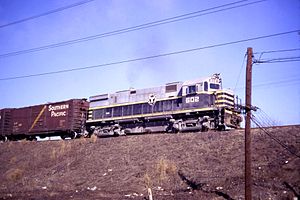Belt Railway of Chicago
 |
|

A Belt Railway ALCO Century 424 locomotive in 1968.
|
|
| Reporting mark | BRC |
|---|---|
| Locale | Chicago and suburbs |
| Dates of operation | 1882–present |
| Track gauge | 4 ft 8 1⁄2 in (1,435 mm) |
| Headquarters | Chicago |
| Website | beltrailway.com |
The Belt Railway Company of Chicago (reporting mark BRC), headquartered in Bedford Park, IL, is the largest switching terminal railroad in the United States. It is co-owned by six Class I railroads — BNSF Railway, Canadian National Railway, Canadian Pacific Railway, CSX Transportation, Norfolk Southern Railway, and Union Pacific Railroad — each of which uses the switching and interchange facilities of the BRC. Owner lines and other railroads bring their trains to the Belt Railway to be separated, classified, and re-blocked into new trains for departure. The BRC also provides rail terminal services to approximately 100 local manufacturing industries. The company employs about 520 people, including its own police force and fire department. Its president is currently Patrick J. O'Brien.
The BRC has 28 miles (45 km) of mainline route with interchanges to each of its owner railroads, and over 300 miles (500 km) of switching tracks. The vast majority of the latter are located in the Clearing Yard.
The Clearing Yard, located on the boundary between Chicago and Bedford Park, Illinois, just south of Chicago Midway International Airport, is one of the largest hump classification facilities in the United States. Some 5.5 miles in length and covering 786 acres (3.2 km²), the yard supports more than 250 miles (400 km) of track. It has six main subdivisions; one arrival, classification, and departure yard in the eastbound and westbound directions.
At the heart of the yard is the wicket-shaped tower which straddles the hump and from which are controlled the switches and retarders of both east- and westbound classification yards to either side of it. Using computer controls, the hump tower efficiently dispatches more than 8,400 rail cars per day. Operating around the clock, employees are able to classify between 40 and 50 miles of consists daily.
...
Wikipedia
